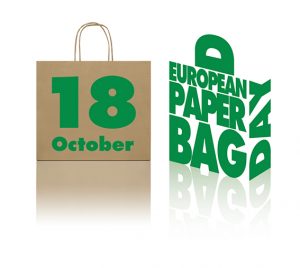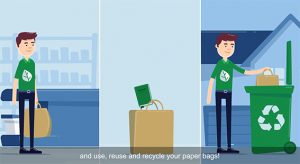 On 18 October, the European Paper Bag Day will be celebrated for the fourth time with various activities throughout Europe. The annual action day was initiated by “The Paper Bag”, Europe’s leading kraft paper manufacturers and paper bag producers platform. It aims at raising awareness among consumers that paper carrier bags are an efficient and sustainable packaging option that can help them to minimise negative impacts on the environment. This year’s events and activities will focus on different aspects of how paper bags contribute to a sustainable future. The new video launched by “The Paper Bag” also gives important insights into this topic. Everyone is welcome to join the activities and discussions.
On 18 October, the European Paper Bag Day will be celebrated for the fourth time with various activities throughout Europe. The annual action day was initiated by “The Paper Bag”, Europe’s leading kraft paper manufacturers and paper bag producers platform. It aims at raising awareness among consumers that paper carrier bags are an efficient and sustainable packaging option that can help them to minimise negative impacts on the environment. This year’s events and activities will focus on different aspects of how paper bags contribute to a sustainable future. The new video launched by “The Paper Bag” also gives important insights into this topic. Everyone is welcome to join the activities and discussions.
From the EU bioeconomy strategy, the Green Deal, the plastics strategy to the plastics tax – at the EU level, many recent initiatives to reduce environmental pollution and prevent climate change will influence the future of packaging design and materials. “Although there are still many uncertainties, we expect that bio-based materials such as paper will have a high priority,” states Elin Gordon, Secretary General of CEPI Eurokraft. “Also, the recycling of packaging will become more important as well as increasing the use and share of recycled fibres. As paper carrier bags meet these and even more qualifications, we are convinced that they are the ideal packaging contributing to a sustainable future.” On the 4th European Paper Bag Day, the platform “The Paper Bag” will promote all the aspects with different online and offline activities throughout Europe. An overview of the events initiated by the members can be found under thepaperbag.org/european-paper-bag-day/events.
Sustainable in material and sourcing
The raw material used in papermaking – cellulose fibre extracted from wood – is a renewable and ever-growing natural resource. The fibres for carrier bags are mostly sourced from sustainably managed European forests. Sustainable forest management is an essential part of the value chain of paper carrier bags. It stimulates the forests’ growth and maintains biodiversity, ecosystems, recreational areas and jobs, and provides a habitat for wildlife. In addition, forests have an enormous potential to mitigate climate change as they store carbon dioxide when they are growing. Scientists describe worldwide afforestation as the most effective measure against climate change[1]. Consumers can look for imprinted labels to see whether a paper bag is made from sustainably sourced fibres. “As currently more and more industries are changing their packaging and their carrier or e-commerce bags from plastic to paper, the sustainable sourcing of the resources is extremely important to protect our planet for future generations – as well as the responsible usage of the resources,” explains Elin Gordon. “Thanks to continuous developments in the paper industry, modern paper packaging enables reducing the material used per bag and keeping a high overall performance at the same time, for example in terms of strength. Adding to that, reusing and recycling plays a vital role for our industry and there are paper bags made from virgin, or with a share of recycled, fibres, depending on the customer’s needs.”
The paper carrier bag cycle: use, reuse, recycle
Paper bags are very strong and can carry a wide range of products up to a weight of 12 kg. They can be reused several times for different occasions. In a four-part video series by “The Paper Bag” the reusability of paper bags is put to the acid test. The same paper bag withstands four uses with heavy loads of around eight kilos or more, as well as challenging shopping items with moisture content and sharp edges and bumpy everyday transport situations. After four trips, it is even good for another use. If paper bags cannot be used any more, consumers can easily recycle them. Europe has a good infrastructure for recycling paper: the recycling rate was 73.9% in 2020. A total of 56 million tonnes of paper were recycled in that year – that is 1.8 tonnes of paper every second.[2] Their long, strong fibres make paper bags a good source for recycling and will be turned into new paper products. And that’s how paper bags are part of the circular economy. Fibres are reused on average 3.8 times in Europe[3]. Recycling paper also reduces emissions produced by landfill sites. “This is how paper bags contribute to a sustainable future in a bio-based and circular economy,” Gordon summarises. “Consumers who want to show responsibility towards a sustainable development should use, reuse and recycle their paper bags.”
New video “Where paper bags come from”
 “The Paper Bag” has produced a short video animation that takes up the topic of this year’s European Paper Bag Day and explains why paper carrier bags are a good choice for consumers and retailers who want to show their commitment towards the environment. It starts with the fibres and ends by closing the loop. It can be watched here: https://www.thepaperbag.org/media/videos.
“The Paper Bag” has produced a short video animation that takes up the topic of this year’s European Paper Bag Day and explains why paper carrier bags are a good choice for consumers and retailers who want to show their commitment towards the environment. It starts with the fibres and ends by closing the loop. It can be watched here: https://www.thepaperbag.org/media/videos.
Everyone is welcome to join the celebrations
An overview on the different events by the members of “The Paper Bag” taking place around the action day are listed online. Under the hashtag #EuropeanPaperBagDay, all activities will also be communicated and shared on the social media channels of “The Paper Bag”: on the Facebook fan page “Performance powered by nature” and the LinkedIn profiles of EUROSAC and CEPI Eurokraft. Consumers are invited to join the discussions, visit the local events or participate in the celebrations with their own activities, using the hashtag.
[1] The global tree restoration potential, Bastin JF, Finegold Y, Garcia C, Mollicone D, Rezende M, Routh D, Zohner CM, Crowther TW, published in Science, 5 July 2019
[2] European Paper Recycling Council, Monitoring Report 2020, 2021
[3] European Paper Recycling Council, Monitoring Report 2020, 2021























